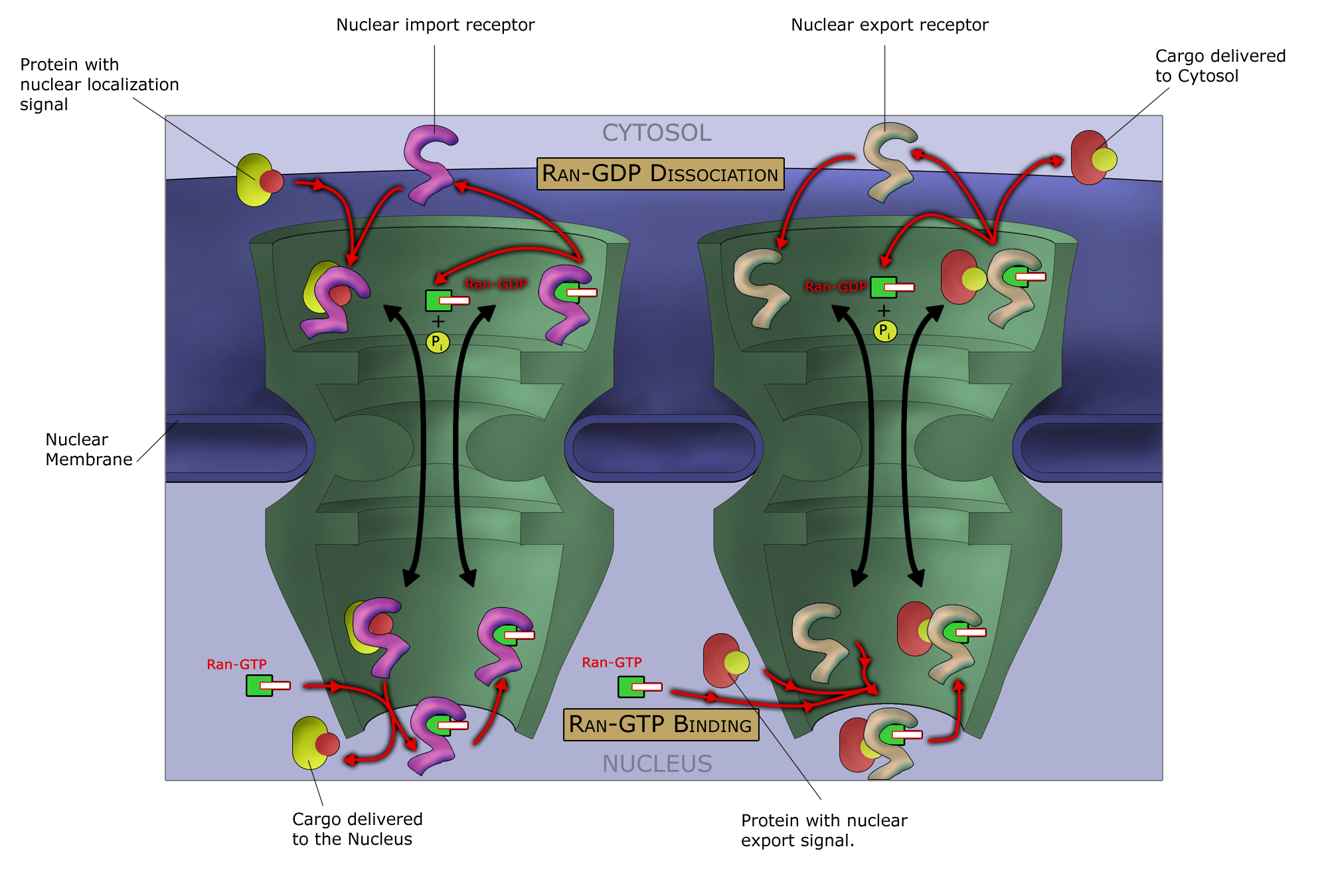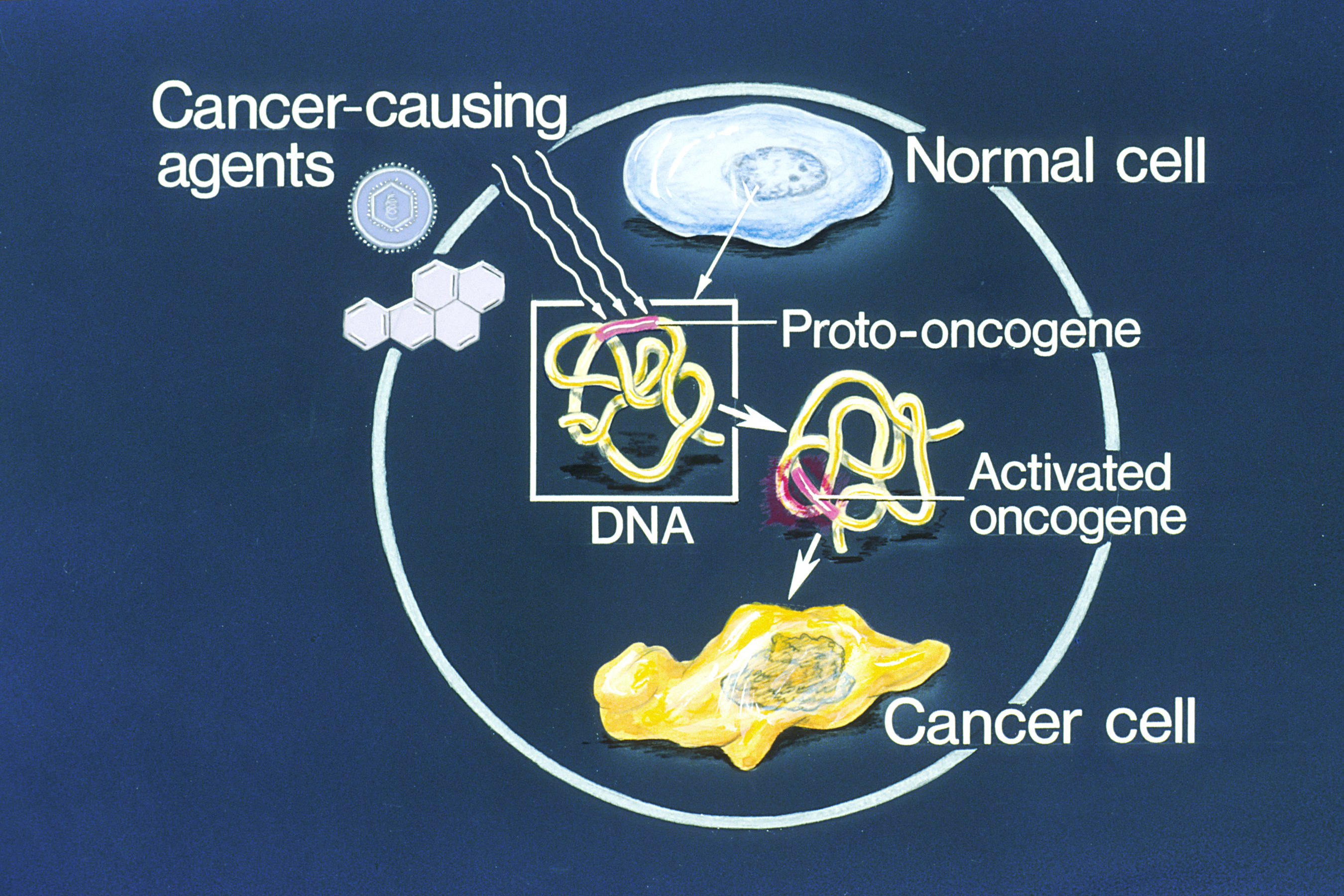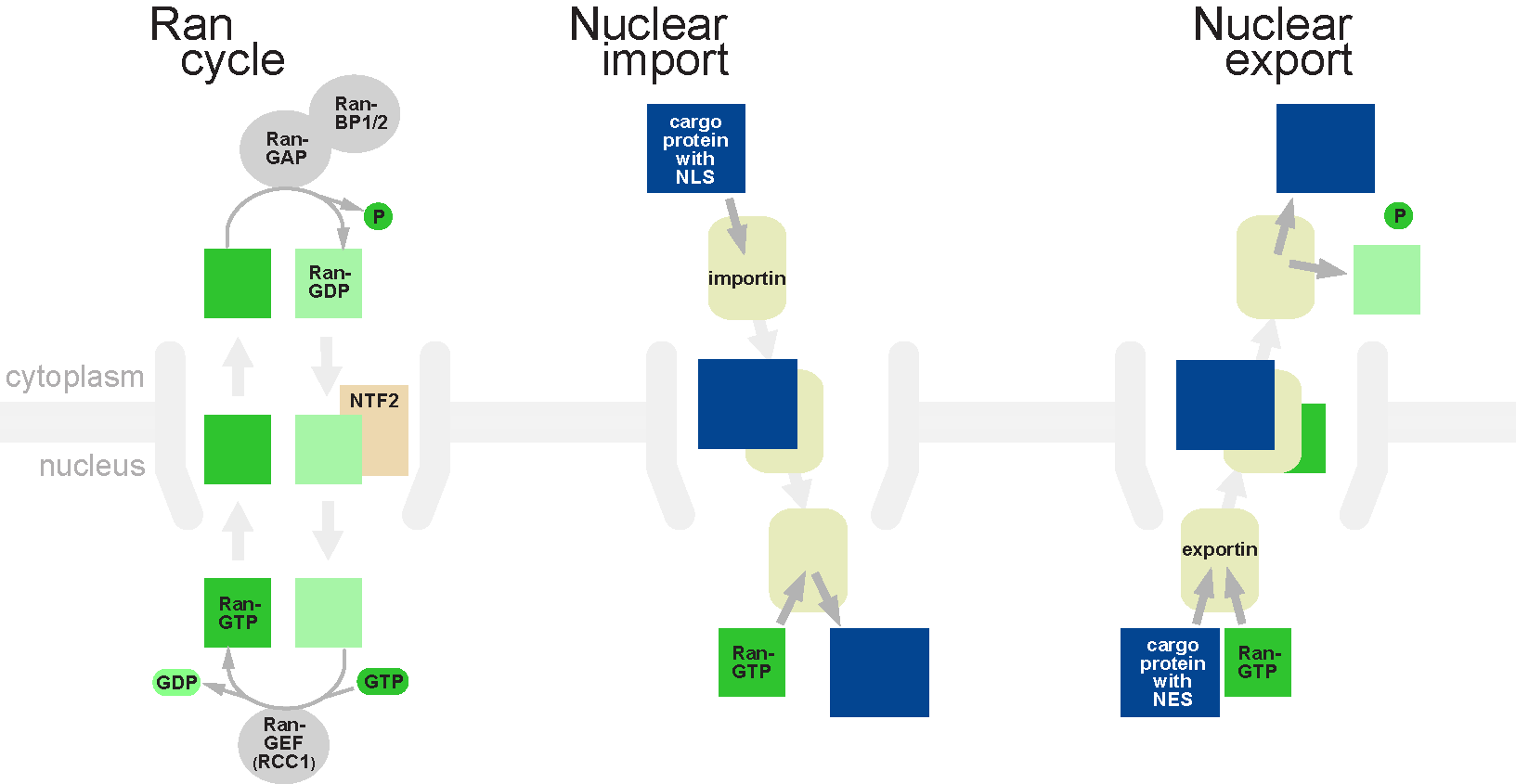|
Selinexor
Selinexor sold under the brand name Xpovio among others, is a selective inhibitor of nuclear export used as an anti-cancer medication. It works by blocking the action of exportin 1 and thus blocking the transport of several proteins involved in cancer-cell growth from the cell nucleus to the cytoplasm, which ultimately arrests the cell cycle and leads to apoptosis. It is the first drug with this mechanism of action. The most common side effects include nausea (feeling sick), vomiting, decreased appetite, weight loss, diarrhea, tiredness, thrombocytopenia (low blood-platelet counts), anaemia (low red-blood cell counts), low levels of white blood cells and hyponatraemia (low blood sodium levels). Selinexor was granted accelerated approval by the U.S. Food and Drug Administration (FDA) in July 2019, for use in combination with the corticosteroid dexamethasone for the treatment of adults with relapsed refractory multiple myeloma (RRMM) who have received at least four prior therap ... [...More Info...] [...Related Items...] OR: [Wikipedia] [Google] [Baidu] |
XPO1
Exportin 1 (XPO1), also known as chromosomal region maintenance 1 (CRM1), is a eukaryotic protein that mediates the nuclear export of various proteins and RNAs. History XPO1 (CRM1) originally was identified in the fission yeast ''Schizosaccharomyces pombe'' in a genetic screen, and investigators determined that it was involved in control of the chromosome structure. It was later shown to be the nuclear transport receptor for cargos with leucine-rich nuclear export signals ( NES). The structural details of the interaction of XPO1 with its cargos were revealed two decades after the gene was identified. Function XPO1 mediates NES-dependent protein transport. It exports several hundreds of different proteins from the nucleus. XPO1 is involved in the nuclear export of ribosomal subunits. XPO1 plays a role in export of various RNAs including U snRNAs, rRNAs (as a part of ribosomal subunits), and some mRNAs. Medical relevance XPO1 is involved in various viral infections. For e ... [...More Info...] [...Related Items...] OR: [Wikipedia] [Google] [Baidu] |
Oral Administration
Oral administration is a route of administration whereby a substance is taken through the Human mouth, mouth, swallowed, and then processed via the digestive system. This is a common route of administration for many medications. Oral administration can be easier and less painful than other routes of administration, such as Injection (medicine), injection. However, the onset of action is relatively low, and the effectiveness is reduced if it is not absorbed properly in the digestive system, or if it is broken down by digestive enzymes before it can reach the bloodstream. Some medications may cause gastrointestinal side effects, such as nausea or vomiting, when taken orally. Oral administration can also only be applied to conscious patients, and patients able to swallow. Terminology ''Per os'' (; ''P.O.'') is an adverbial phrase meaning literally from Latin "through the mouth" or "by mouth". The expression is used in medicine to describe a treatment that is taken orally (but not ... [...More Info...] [...Related Items...] OR: [Wikipedia] [Google] [Baidu] |
Food And Drug Administration
The United States Food and Drug Administration (FDA or US FDA) is a List of United States federal agencies, federal agency of the United States Department of Health and Human Services, Department of Health and Human Services. The FDA is responsible for protecting and promoting public health through the control and supervision of food safety, tobacco products, caffeine products, dietary supplements, Prescription drug, prescription and Over-the-counter drug, over-the-counter pharmaceutical drugs (medications), vaccines, biopharmaceuticals, blood transfusions, medical devices, electromagnetic radiation emitting devices (ERED), cosmetics, Animal feed, animal foods & feed and Veterinary medicine, veterinary products. The FDA's primary focus is enforcement of the Federal Food, Drug, and Cosmetic Act (FD&C). However, the agency also enforces other laws, notably Section 361 of the Public Health Service Act as well as associated regulations. Much of this regulatory-enforcement work is ... [...More Info...] [...Related Items...] OR: [Wikipedia] [Google] [Baidu] |
Oncogene
An oncogene is a gene that has the potential to cause cancer. In tumor cells, these genes are often mutated, or expressed at high levels.Kimball's Biology Pages. "Oncogenes" Free full text Most normal cells undergo a preprogrammed rapid cell death () if critical functions are altered and then malfunction. Activated oncogenes can cause those cells designated for apoptosis to survive and proliferate instead. Most oncogenes began as proto-oncogenes: normal genes involved in cell growth and proliferation or inhibition of apoptosis. If, through mutation, normal genes promoting cellular growth are up-regulated (gain-of-function mutation), they predispose the cel ... [...More Info...] [...Related Items...] OR: [Wikipedia] [Google] [Baidu] |
Tumor Suppressor
A tumor suppressor gene (TSG), or anti-oncogene, is a gene that regulates a cell (biology), cell during cell division and replication. If the cell grows uncontrollably, it will result in cancer. When a tumor suppressor gene is mutated, it results in a loss or reduction in its function. In combination with other genetic mutations, this could allow the cell to grow abnormally. The Loss-of-function mutation, loss of function for these genes may be even more significant in the development of human cancers, compared to the activation of oncogenes. TSGs can be grouped into the following categories: caretaker genes, gatekeeper genes, and more recently landscaper genes. Caretaker genes ensure stability of the genome via DNA repair and subsequently when mutated allow mutations to accumulate. Meanwhile, gatekeeper genes directly regulate cell growth by either inhibiting cell cycle progression or inducing apoptosis. Lastly, landscaper genes regulate growth by contributing to the surrounding e ... [...More Info...] [...Related Items...] OR: [Wikipedia] [Google] [Baidu] |
Nuclear Transport
Nuclear transport refers to the mechanisms by which molecules move across the nuclear membrane of a cell. The entry and exit of large molecules from the cell nucleus is tightly controlled by the nuclear pore complexes (NPCs). Although small molecules can enter the nucleus without regulation, macromolecules such as RNA and proteins require association with transport factors known as nuclear transport receptors, like karyopherins called importins to enter the nucleus and exportins to exit. Nuclear import Protein that must be imported to the nucleus from the cytoplasm carry nuclear localization signals (NLS) that are bound by importins. An NLS is a sequence of amino acids that acts as a tag. They are most commonly hydrophilic sequences containing lysine and arginine residues, although diverse NLS sequences have been documented. Proteins, transfer RNA, and assembled ribosomal subunits are exported from the nucleus due to association with exportins, which bind signaling sequences calle ... [...More Info...] [...Related Items...] OR: [Wikipedia] [Google] [Baidu] |
Karyopherin
Karyopherins are protein Proteins are large biomolecules and macromolecules that comprise one or more long chains of amino acid residue (biochemistry), residues. Proteins perform a vast array of functions within organisms, including Enzyme catalysis, catalysing metab ...s involved in transporting molecules between the cytoplasm and the nucleus of a eukaryotic cell. The inside of the nucleus is called the karyoplasm (or nucleoplasm). Generally, karyopherin-mediated transport occurs through nuclear pores which act as a gateway into and out of the nucleus. Most proteins require karyopherins to traverse the nuclear pore. Karyopherins can act as '' importins'' (i.e. helping proteins get into the nucleus) or ''exportins'' (i.e. helping proteins get out of the nucleus). They belong to the nuclear pore complex family in the transporter classification database (TCDB). Energy for transport is derived from the Ran gradient. Upon stress, several karyopherins stop shuttling betwee ... [...More Info...] [...Related Items...] OR: [Wikipedia] [Google] [Baidu] |
Selective Inhibitor Of Nuclear Export
Selective inhibitors of nuclear export (SINEs or SINE compounds) are drugs that block exportin 1 (XPO1 or CRM1), a protein involved in transport from the cell nucleus to the cytoplasm. This causes cell cycle arrest and cell death by apoptosis. Thus, SINE compounds are of interest as anticancer drugs; several are in development, and one ( selinexor) has been approved for treatment of multiple myeloma as a drug of last resort. The prototypical nuclear export inhibitor is leptomycin B, a natural product and secondary metabolite of ''Streptomyces'' bacteria. Although it is nonselective and too toxic for clinical use in humans, the discovery of its mechanism of action and antitumor properties prompted development of the SINE compounds. Mechanism of action SINEs work by binding to CRM1, a karyopherin which performs nuclear transport of hundreds of proteins—including tumor suppressors, oncogenes, and proteins involved in governing cell growth—from the cell nucleus to the cytopla ... [...More Info...] [...Related Items...] OR: [Wikipedia] [Google] [Baidu] |
Multiple Myeloma
Multiple myeloma (MM), also known as plasma cell myeloma and simply myeloma, is a cancer of plasma cells, a type of white blood cell that normally produces antibody, antibodies. Often, no symptoms are noticed initially. As it progresses, bone pain, anemia, Kidney failure, renal insufficiency, and infections may occur. Complications may include hypercalcemia and amyloidosis. The cause of multiple myeloma is unknown. Risk factors include obesity, radiation exposure, family history, age and certain chemicals. There is an increased risk of multiple myeloma in certain occupations. This is due to the occupational exposure to aromatic hydrocarbon solvents having a role in causation of multiple myeloma. Multiple myeloma is the result of a multi-step malignant transformation, and almost universally originates from the pre-malignant stage monoclonal gammopathy of undetermined significance (MGUS). As MGUS evolves into MM, another pre-stage of the disease is reached, known as Smouldering ... [...More Info...] [...Related Items...] OR: [Wikipedia] [Google] [Baidu] |
First-in-class Medication
A first-in-class medication is a prototype drug that uses a "new and unique mechanism of action" to treat a particular medical condition. While the Food and Drug Administration's Center for Drug Evaluation and Research tracks first-in-class medications and reports on them annually, first-in-class is not considered a regulatory category. Although many first-in-class medications qualify as breakthrough therapies, Regenerative Medicine Advanced Therapies and/or orphan drugs, first-in-class status itself has no regulatory effect. Examples Controversy Safety By definition, a first-in-class drug does not have the safety evidence from analogous products that not-first-in-class drugs would have. However, a study investigating recalls and warnings in relation to first-in-class drugs approved between 1997 and 2012 by Health Canada has found that first-in-class drugs actually have a more favourable benefit-to-harm ratio. Economics First-in-class drugs are often seen as commerc ... [...More Info...] [...Related Items...] OR: [Wikipedia] [Google] [Baidu] |
Medscape
Medscape is a website providing access to medical information for clinicians and medical scientists; the organization also provides continuing education for physicians and other health professionals. It references medical journal articles, Continuing Medical Education (CME), a version of the National Library of Medicine's MEDLINE database, medical news, and drug information (Medscape Drug Reference, or MDR). At one time Medscape published seven electronic peer reviewed journals. History Medscape launched May 22, 1995, by SCP Communications, Inc. under the direction of its CEO Peter Frishauf. The first editor of Medscape was a P.A. named Stephen Smith. In 1999, George D. Lundberg became the editor-in-chief of Medscape. For seventeen years before joining Medscape he served as editor of the ''Journal of the American Medical Association''. In September 1999, Medscape, Inc. went public and began trading on NASDAQ under the symbol MSCP. In 2000, Medscape merged with MedicaLogic, In ... [...More Info...] [...Related Items...] OR: [Wikipedia] [Google] [Baidu] |





